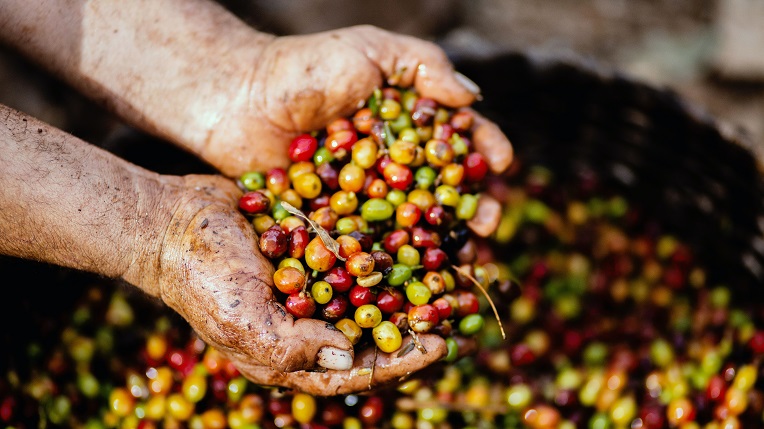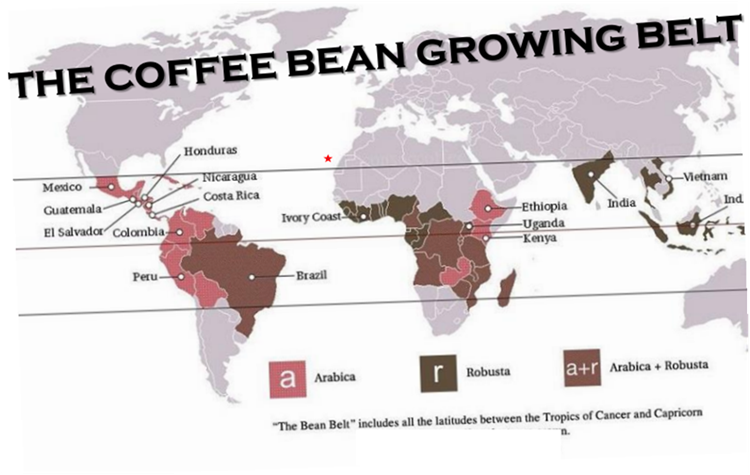Coffee plant History and general Information

This post is also available in:
This post is also available in:
![]() Français (French)
Français (French) ![]() Deutsch (German)
Deutsch (German) ![]() العربية (Arabic)
العربية (Arabic) ![]() 简体中文 (Chinese (Simplified))
简体中文 (Chinese (Simplified)) ![]() Português (Portuguese (Brazil))
Português (Portuguese (Brazil))
Coffee has gained huge economic, social, and cultural importance in modern times. According to the International Trade Centre, more than $36.3 billion[1] dollars of coffee exports were traded during the 2021/22 season. However, this amount only accounts for the trade between nations. Numbers become even higher when processed and sold to the final consumers in various forms. Undoubtedly, it is one of the world’s most popular drinks; roughly 3 billion cups of coffee are consumed daily[2].
To understand how coffee has gained enormous popularity, we need to dive into its history. There is no clear record of how and when humans began consuming coffee, but most researchers agree on its whereabouts. Coffee plants are native to the Abyssinia region, now mostly modern-day Ethiopia. However, thanks to the civet, it spread over time through different African regions. These nocturnal animals tend to eat fully matured coffee berries, but their digestive system is just able to digest the pulp and honey of the fruit, while the green bean only ferments inside them before being excreted. As they moved, they spread through the land the coffee beans, which eventually turned into coffee forests.
Many stories have been told about its true origin, but without a doubt, the most popular and romantic one is that of Kaldi. Some say he was a Yemeni immigrant working as a goat herder in Abyssinia. One day, while looking for his herd, he hiked through the mountains and found them agitated, jumping and dancing around. He soon realized that they had been eating the berries and leaves of a bushy tree. Those little berries intrigued him. After making sure they were not poisonous, he began chewing them, and so, according to this legend, this was humanity’s first approach to this particular fruit. It did not take long before human creativity led to more ingenious ways of processing the beans of bunn as it was named back then.
It is important to keep in mind some events that lead to the coffee culture that we experience nowadays:
- In the 900s (CE), the Persian physician Abū Bakr al-Rāzī, also known as Al Razi or Rhazes, described the properties of a drink called bunchun which was prepared through a prior form of brew using coffee berries. It is believed that coffee trees had already been cultivated for a couple of centuries by this time.
- 1300 (CE), monks begin to drink and prepare it in a ceremony.
- 1400 (CE), coffee becomes a well know social drink in the Arab world. Mohammedan pilgrims had extracted and taken the beans in their bags to Mecca.
- 1500 (CE), the beverage called quwwa earned a bad reputation, and word about it being a like wine and intoxicant drink spread, so it was briefly outlawed under Muslim law
- 1536 (CE) Coffee beans are widely exported throughout the Turkish Empire.
- 1600-99 (CE) coffee is smuggled and successfully cultivated in southern India. The first coffee exports arrived in Europe; the Dutch started to grow plantations in Ceylon (now Sri Lanka), Sumatra, Timor, and Bali.
- 1700-1724 (CE) up to this point, beans had been exported to Europe, but trees had not been able to germinate successfully under the region’s climate. After various attempts, finally, some plants are grown at Hortus Botanicus in Amsterdam and Jardin des plantes de Paris. These plants are soon extracted and taken to colonies in the Americas, where they are successfully grown[3].
The coffee route is certainly interesting, and the above summary helps provide an idea of how it spread throughout the different regions of the world that nowadays hold a strong history and tradition of planting and growing this crop. However, this route is just one of the two main factors that allowed plantations to exist at their present locations; the second one is that these countries are located under the Coffee Belt, the regions between the Tropic of Cancer and Tropic of Capricorn (25 degrees north and 30 degrees south) where we can find cool and tropical climates with the right conditions for it to thrive:
- Temperatures of the regions oscillate between 17° to 26° C (63-79 °F). If temperatures go below 16°C, the risk of leaf burns increases, while above 27°C (81 °F), there is a reduction of photosynthesis due to dehydration.
- Altitudes between 900 to 1600 MASL (meters above sea level)(generally speaking) are considered ideal for vast coffee production; however, coffee does grow in altitudes around 600 to 800 MASL, but since the bean matures at a faster pace in these areas, its quality tends to be less desired. It can also grow at altitudes above 1600 MASL. In some regions like Huehuetenango and Acatenango Valley in Guatemala or the Nariño region in Colombia, plantations have reached an average of 2000 MASL, and they tend to be highly sought-after beans; however, not every region with this altitude is ideal because the plants might not fully develop.
- Wind speed above 30 km per hour damages the trees, flowers, and fruits. It causes leaf fall and dehydrates leaf buds.
- Rain is quintessential, but too much might promote the growth of harmful fungi, while too little reduces the number of berries produced per tree. The ideal precipitations range is between 1,000 to 3,000 millimeters (mm) per year. Having said this, coffee plantations should register humidity ranges between 65% to 90%[4].
As we can see, this crop is quite delicate, so only some countries located in the belt are able to grow it. More than fifty countries currently produce coffee and export their beans.[5]

According to the U.S. department of agriculture, every 100g of coffee brewed with tap water contains[6]:
| Energy | 1 Kcal |
| Energy | 2 KJ |
| Protein | 0.12 g |
| Total lipid (fat) | 0.02 g |
| Calcium, Ca | 2 mg |
| Magnesium, Mg | 3 mg |
| Phosphorus, P | 3 mg |
| Potassium, K | 49 mg |
| Sodium, Na | 2 mg |
| Caffeine | 40 mg |
As we can see from the above table, Caffeine is one of the main components of this crop. There are many myths surrounding it and its possible negative effects. However, an intake of 400 mg [7] of coffee per day (3 to 5, 8 oz cups) has been proven to be a safe intake, always keeping in mind that it is not a nutrient but rather a dietary component. On the other hand, various sources and studies promote a healthy consumption of coffee by stating its benefits, such as longevity[8], promoting a lower risk of type 2 diabetes[9], and mental health[10], among others.
This article intends to serve as an introduction and contains general information that helps understand how this crop grows and develops. As we will discover in further articles, these facts might vary and change as other factors such as the coffee trees varieties and subspecies, soil, micro-climates, and altitudes, among others, will have a direct impact on the different techniques, care, and even technology required for handling each plantation.
References
[1] American billions, equivalent to 36.3 thousand million in other parts of the world.
[2] The Coffee Guide, Fourth Edition, 2021, International Trade Centre, p.XXII. 5718 (intracen.org)
[3] Mark Pendergrast, 2010, Uncommon Grounds. The history of Coffee and How it transformed our world, chapter 1.
Regina Wagner, 2001, The History of Coffee in Guatemala, p.20
[4] Esther Hernández, Francisco Pérez, Lucia Godínez, La producción y el consumo de café, ECORFAN, P.6, LIBRO_CAFE.pdf (ecorfan.org)
[5] Image taken from: International Coffee Organization pscb-165e-report.pdf (ico.org)
[6] FoodData Central (usda.gov)
[7] Dietary Guidelines for Americans 2020-2025, USDA, P.35 Dietary Guidelines for Americans, 2020-2025
[8] Caffeinated and decaffeinated coffee consumption and risk of all-cause mortality: a dose-response meta-analysis of cohort studies by Li et al., Journal of Human Nutrition and Dietetics
[9] Coffee components inhibit amyloid formation of human islet amyloid polypeptide in vitro: possible link between coffee consumption and diabetes/ by Cheng et al, in the Journal of Agricultural and Food Chemistry (2011)
[10] ‘Coffee Drinkers Are Less Likely Than Others to be Depressed — a Review of Current Research on Coffee, Depression and Depressive Symptoms by Dr. Alan Leviton, Harvard Medical School
Coffee plant History and general Information
Coffee Plant Information – Morphology
Coffee Genetics and Variety Selection
How to Select, and Treat Coffee Seeds
Germination of Coffee Seeds and Creation of Seedbeds for Planting
Coffee Trees Planting and Plant Spacing
How to Prune your Coffee Trees in an Agroforestry System
Shade-Grown Coffee in an Agroforestry System
Coffee Tree Flowering and Pollination
From Rainwater Harvesting to Irrigation of Coffee Trees
Coffee Tree Fertilization Requirements
Weed Management in a Coffee Plantation








































































